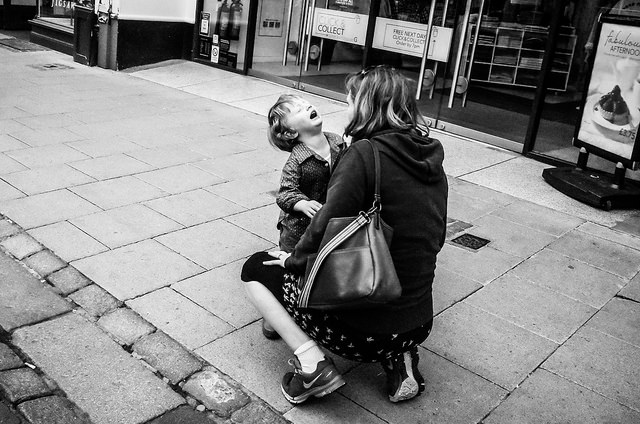My favorite time of day is noon.
I’m usually in the living room hunched over my laptop, promoting my book or working on an article. Then suddenly my single-pointed focus is interrupted. A loud scream rips me away from my computer. I immediately feel irritated.
I want to finish what I’m working on: write one more paragraph, make one more change, just get to a good stopping point. But that cry will not be ignored. It pierces my concentration.
I put my work aside and make my way down the hall. As soon as I open the door that cry is transformed into an innocent laugh. My frustration falls away. I crawl in the bed with my two-year-old son. He lies next to me smiling, but only for a second before he starts climbing on top of me.
There is nowhere else I would rather be. This is my favorite time of the day.
All of the world’s great spiritual traditions agree that self-centeredness is at the root of human suffering. And they all provide us with practices meant to peel us away from our identification with the false self. Meditation, prayer, yoga, self-examination, and study all help dissolve our delusion and shine the light of awareness on the false-self.
But daily life is the only practice I have encountered that ruthlessly slaps at our self-grasping hand. This is particularly true of relationships.
Spirituality is an ambiguous word. I define it as “a resonant mythos infused with an actionable path of self-analysis, prayer, and meditation that enables us to transcend the false-self system and reconnect with the vitality of the body.”
In short, spirituality is concerned with one thing and one thing only: transcending the ego.
This can happen in meditation, prayer, savasana. It can happen while we are walking, running, or studying. But it can also happen while we are loading the dish washer, cutting the grass, or arguing with our spouse—if we are present and willing to respond with authenticity. The moment of awakening might be heralded in by a honking horn or a crying baby, rather than a meditation bell or a choir of angels.
There is more than one way to skin a Buddha.
The Tantric traditions of India—Buddhist and Hindu—have long understood the immense spiritual potential packed into daily life. In these traditions it is the moms and dads, the husbands and wives, the shopkeepers and farmers that are venerated, not the monk or the recluse.
Unfortunately, daily life is too often seen as an obstacle to spiritual growth, rather than the path itself. Perhaps our spouse says something that pushes our button or our child is being especially needy that day. We become impatient. Anger and frustration start bubbling up. The ego’s tendency is to blame the other. It lays our feelings at their feet. It says that our frustration is the result of their behavior. This leaves us feeling stuck.
Blame chains us to our misery, waiting on the other to change their ways so we can be happy.
The truth is that our feelings are the result of our own self-clinging. Circumstances expose the ego. They point out the areas of our life the ego has claimed.
When my child wakes up from his nap and his cries pull me away from my work, I’m only frustrated because I am identified with that work. I have become hyper-focused on that work. In the Buddhist tradition, we would say I’m living in the animal realm—piggishly pressing forward with blinders on that blot out everything except for the mud hole my ego is wallowing in.
In my case, it is doubly interesting because I am most likely writing about spirituality when all of this happens, which means I’m looking at the finger and not the moon. I am focused on the words but have forgotten their meaning.
Spiritual practice is about letting go of the ego. When daily life exposes our self-grasping tendencies, we are granted an opportunity to actually practice spiritual principles. In that moment, a portal opens. If we choose to drop our self-centered narrative and step through that gate, we discover our path.
Spirituality does not exist independent of our suffering. The Buddha said as much in the First Noble Truth. “Our path” is like a series of stepping stones that appear the moment we become aware of our shortcomings. What we call obstacles, pitfalls, and shortcomings, the Buddha calls the spiritual path.
Spiritual principles do not exist in a vacuum. They are born into the world through our actions and daily life is our midwife. Take patience as an example. In order to practice patience, there must be an asshole trying our nerves. When someone pushes our buttons they are inviting us onto our path. Without impatience the practice of patience is just a simulation. This is true of all spiritual principles.
We cannot practice generosity without a needy person—whether that be a toddler or a beggar—demanding something of us that we cling to. Morality is little more than a self-righteous façade without the presence of temptation. It is temptation that invites us to move beyond self-will by affording us the occasion to do what is right, regardless of whether we stand to profit from it or not.
We often think of freedom as the ability to do whatever we want, whenever we want. This is not freedom. It is bondage. It is the bondage of ego.
True freedom is found in freedom from self. When we are free of the ego we are no longer reactive. If, when our buttons are pressed, we move beyond the petulant, self-centered narrative between our ears, down into the silence of body, we will discover the power to meet anger with loving-kindness, fear with courage, temptation with character, and our frustrations with patience.
This is spiritual growth. Growth doesn’t happen in the safe and quiet space of bedroom. We cultivate the capacity to let go during our formal practice, but true growth happens in relationship.
Meditation, prayer, and yoga are all practices—and practice is essential—but daily life is where the rubber meets the road.
Practice pulls back the veil a bit. It enables us to glimpse the truth of selflessness, but that truth is born into the world through our actions. It is in daily life, in relationship—when we are caught up in self clinging—then and only then, are we afforded the opportunity to let go.
We cannot practice letting go, unless we are holding onto something. Anytime we are disturbed—whether we are angry, depressed, jealous, afraid, obsessed, or bored—it is because we are clinging to ego. This clinging is not only the cause of our suffering, it is the only thing that prevents us from reconnecting with our True Life. And we are often unaware of this clinginess until something tries to pry open our hand. So when we step off of the cushion or the mat and into our daily life, we are passing through the eye of the needle. We are stepping onto the path and on the spiritual path, the meditation bell sounds more like a crying child or a beggar asking for a dollar.
I will close with a relevant excerpt from my book Finding God in the Body: A Spiritual Path for the Modern West:
“Relationships are difficult because they demand that we give of our Self. This is hard because the false-self is selfish. It wants to avoid discomfort and clings to immediate gratification. Creative love matures us by reminding us that we cannot hope to grow into our True Self without something demanding our false-self in return.
“The resurrection of our True Life is proportionate to the death of our inauthentic life. The false-self is incapable of accepting this truth. It is bound to itself. Love is free to accept this maxim. This is the power of love to endure all things: marriage, divorce, success, failure, friendship, rivalries, heartache, and death. The freedom of love enables us to adapt to life’s changing circumstances. From the point of view of creative love, there are no problems, only opportunities. If the problem can be solved it is not a problem, just something for you to work with; if it can’t be solved, it is not a problem, just something to accept and move on. Creative love sees everything as workable.”
Author: Benjamin Riggs
Image: Flickr/Lubomir Simek
Editor: Callie Rushton









Read 1 comment and reply